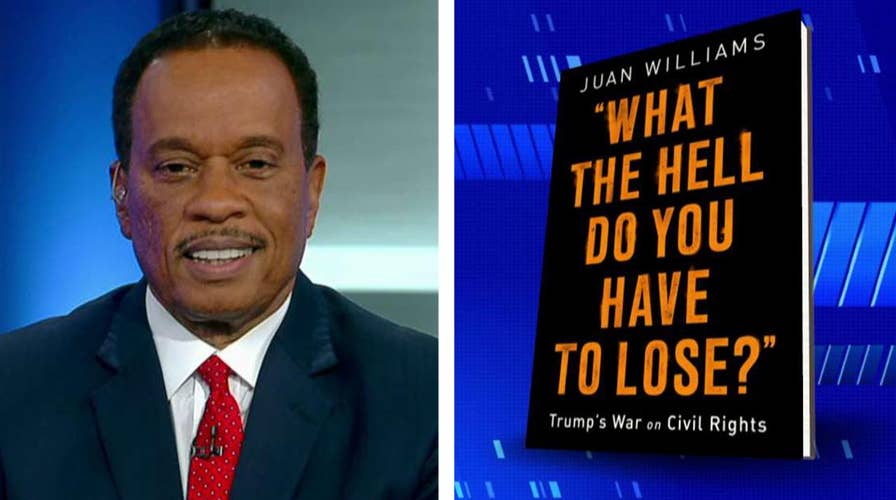Juan Williams discusses 'What the Hell Do You Have to Lose?'
'The Five' co-host Juan Williams explains why he wrote his latest book 'What the Hell Do You Have to Lose? Trump's War on Civil Rights.'
Editor's note: Excerpted from “What The Hell Do You Have to Lose? Trump’s War on Civil Rights.
After President Kennedy was shot and killed on November 22, 1963, President Lyndon Baines Johnson made the passage of the Civil Rights Act into an almost spiritual affair, a way to do justice to the dead president.
On the twenty-seventh of November, he told a joint session of Congress: “No memorial oration or eulogy could more eloquently honor President Kennedy’s memory than the earliest possible passage of the civil rights bill for which he fought so long.” On February 10, 1964, the bill passed through the House, 290 to 130.
But sympathy for the assassinated president did not move Southern Democrats.
Richard Russell, the powerful Georgia senator, had long condemned the plan while the president was alive. He called it “a threatened crime against the whole philosophy of liberty,” because it would force white people to associate with black people against their wishes.

Senator John Stennis of Mississippi had called it a “vicious proposal.”
Lister Hill, a senator from Alabama, accused President Kennedy of putting “our most sacred rights . . . on the altar of political expediency.”
Editorials in the South’s leading papers denounced the bill as “another step in the direction toward a dictatorship in this country,” as Mississippi’s Meridian Star newspaper put it.
The Johnson administration knew there would be a Senate filibuster by the Southern segregationists. With the loss of those Democrats they’d need Republican support. The bill had to have sixty-seven votes, the super majority necessary to end the filibuster. Specifically, they’d need more than half of the thirty-three Republicans currently serving in the Senate.
Republicans, almost exclusively from the Northern and Western states outside the South, generally favored civil rights. But they opposed government telling white people that they had no choice but to follow orders and mix with black people. That was seen as an encroachment on individual liberties.
President Johnson identified one Republican as the senator able to convince fellow Republicans in the Senate to back the bill: Everett Dirksen.
Dirksen had promised to support the civil rights bill when the late President Kennedy announced it the previous June. And yet, as a conservative, Dirksen was not completely on board with Title II, the public accommodations provision.
He also took issue with Title VII, which banned employment discrimination. Dirksen wasn’t sure whether it was the job of the Department of Justice to determine and punish the individuals and businesses that were being discriminatory. The central problem posed by the bill, as Dirksen wrote in his private notebook in capital letters, was whether: “congress [can] destroy FREEDOM OF ASSOCIATION in the case of privately owned and operated businesses.” With a taste for the dramatic, during a February 1964 press conference, Dirksen said that he took his freedom the way he took his drinks: “Straight.”
A diehard believer in the Senate as an institution, Dirksen also had some major qualms about breaking filibusters. Dirksen had once said they were “the only brake on hasty action.”
And yet, tentatively, and with major reservations, Dirksen went to work.
It’s hard to overestimate the spectacle of it all. On the one hand, the whole world watched as the Senate began to debate the most anticipated bill of the 20th century.
When the expected Southern filibuster began on March 30, 1963, Americans watched as senator after senator from the Southern segregationist bloc delivered racist tirades at the lectern.
At one point, Senator Russell Long of Louisiana argued: “The good Lord did as much segregating as anyone I know of when he put one race in one part of the world and another race in another part of the world.” During a later speech, the senator debated whether “it not be fair to ask what kind of fix the colored folks would be in if they had not been brought to this country, but had been allowed to roam the jungles, with tigers chasing them.”
Senator Jim Eastland of Mississippi said that he had “lived in the south my whole life” and had “not seen the first instance of economic discrimination.”
Senator George Smathers, a Florida Democrat, claimed it was the Southerners who where the real victims of discrimination: “No southerner has been elected president of the United States for more than 100 years. Why? Because of discrimination.”
And Senator Olin Johnston of South Carolina asked whether desegregation was the right move, given that there was more crime in the desegregated North than in the Jim Crow South.
And yet, as all of this absurdity was happening on the Senate floor, here was the sixty-eight-year-old Everett Dirksen, who hadn’t really given much thought to civil rights during his career, suddenly working day in and day out to engineer revisions to the version of the civil rights bill that the House had passed that winter.
His goal was to make it acceptable to small-government conservatives in the Midwest. He assigned a group of lawyers from the Judiciary Committee— nicknamed Dirksen’s Bombers— to go through the bill line by line, looking for wiggle room, particularly in the portions that dealt with public accommodations. They looked for places where the bill’s language could be broadened just enough to assure conservatives that the bill was not an encroachment on individual liberties.
Simultaneously, Dirksen needed to be sure that the changes he proposed were acceptable to Democrats, specifically Majority Leader Mike Mansfield and Majority Whip Hubert Humphrey. They were under pressure from President Lyndon Johnson to make a deal with Dirksen, but the Senate Democrats also faced pressure from NAACP lobbyist Clarence Mitchell and the powerful Washington union lawyer Joe Rauh Jr. not to allow Republicans to gut the bill and repeat the mistakes that had weakened the previous civil rights acts.
All the while, Dirksen maintained a dynamic mental map of his caucus: thirty-three Senate Republicans, seven of whom tilted liberal, five of whom were moderate, and twenty-one of whom, including himself, were conservative. A majority of them would be needed to successfully invoke cloture, a procedural rule designed to counter filibusters by forcing a vote.
And so Dirksen and his Bombers tossed out some amendments while insisting on others. A key instance of the kind of work Dirksen performed was the way he and Majority Leader Mansfield chose to define “discrimination.”
This was crucial, because if the Justice Department found instances of discrimination in public accommodations or employment, they’d be able to bring criminal charges against people and businesses. The issue, as author Charles Garrettson put it in a biography of Senator Humphrey, was “delineating when and to what degree the federal government in general, and the Attorney General specifically, would be authorized to intervene.”
Dirksen and the Democrats’ staff decided that the bill would use the phrase “pattern and practice of discrimination” to describe which businesses and employers the Justice Department would charge with breaking the law.
Dirksen also called for language to prevent the Justice Department from instituting racial quota systems, even for businesses that were found to demonstrate a “pattern and practice of discrimination.” If and when allegations of employment discrimination came up, Dirksen provided for a grace period when state and local governments—not the Justice Department—would have the chance to punish or otherwise deal with the employer who was breaking the law.
Dirksen knew that, in order to get Senate Republicans on board, he also needed them to believe that it wasn’t being shoved down their throats by big-government Democrats.
Meetings were held in Dirksen’s office to reassure Republican senators that he was in charge. In fact, many of the changes that Dirksen made to the House bill weren’t even that major. They were meant to assure Republicans that they controlled the final version of the bill.
By mid-May, Dirksen was feeling confident that he’d be able to get enough votes to invoke cloture. When President Johnson asked Senator Humphrey in a telephone conversation whether “Dirksen [can] get the votes for cloture,” Humphrey responded: “Yes sir, he can get 25 votes. I had dinner with him last night and, Mr. President, we’ve got a much better bill than anybody ever dreamed possible.”
On June 10, the day that had been set to attempt cloture, Dirksen lumbered to the front of the Senate to deliver the most important speech of his career.
The senator was weak on his feet. As he spoke, an aide had to hand him some pills to swallow. Only a few weeks earlier he’d been bedridden with a cold. It wasn’t anything serious. But for the last several months, this sixty-eight-year-old had been working nonstop.
Now that all of this heavy lifting was done, Dirksen decided to skip the nitty-gritty details and frame the bill instead as a biblical battle between Good and Evil: “It is said that on the night he died, Victor Hugo wrote in his diary, substantially, this sentiment: ‘Stronger than all the armies is an idea whose time has come.’ ”
The time had come. When Senator Lee Metcalf, a Montana Democrat, asked the room whether “the debate shall be brought to a close,” seventy-one senators voted to invoke cloture, with only twenty-nine voting “nay.” It was four more votes than President Johnson needed.
Nine days later, the bill passed through the Senate with seventy-three votes.
In a brief White House speech on July 2, President Johnson urged the nation to “hasten that day, when our unmeasured strength, and our unbounded spirit, will be free to do the great works ordained to this nation by the just and wise God, who is the Father of us all.”
He then signed the Civil Rights Act into law. At the end of the ceremony, the president gave souvenirs to the people in attendance, He had used seventy-five pens to sign the law. He handed the first pen to Dirksen, the Republican Senator without whom the bill would not have become a law.
Excerpted from “What The Hell Do You Have to Lose? Trump’s War on Civil Rights. ,” by Juan Williams. Reprinted with permission from PublicAffairs, a division of the Hachette Book Group.

